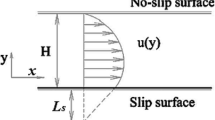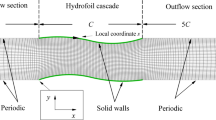Abstract
Flow around a traveling wave-based surface-undulating NACA0012 hydrofoil has been numerically studied. In particular, we determine the effect of the phase speed of the wave, the phase difference between the waves traveling on the top and bottom surfaces, and the wave number on flow dynamics around and behind the hydrofoil and propulsive performance. The flow results in a vortex sheet or a street behind the hydrofoil, where oppositely signed vortices are aligned in either forward or reverse direction. Apart from these, side vortices start forming on either side of the hydrofoil at a higher wave number. The phase difference analysis between the upper and lower surface undulation reveals the configuration better for the hydrofoil’s lateral and longitudinal stability. The hydrofoil can shift from high thrust to high lateral force configuration by changing the phase difference between waves on the top and bottom surfaces. Thrust increases with an increase in the wave number, and a threshold value of phase speed and wave number exists where the drag-to-thrust transition happens. The added mass force-based scaling analysis corroborates with the simulated results.
Graphic abstract













Similar content being viewed by others
References
Triantafyllou, M.S., Techet, A.H., Hover, F.S.: Review of experimental work in biomimetic foils. IEEE J. Oceanic Eng. 29(3), 585–594 (2004). https://doi.org/10.1109/JOE.2004.833216
Gazzola, M., Argentina, M., Mahadevan, L.: Scaling macroscopic aquatic locomotion. Nat. Phys. 10(10), 758–761 (2014). https://doi.org/10.1038/nphys3078
Triantafyllou, M.S., Triantafyllou, G., Yue, D.: Hydrodynamics of fishlike swimming. Ann. Rev. Fluid Mech. 32(1), 33–53 (2000). https://doi.org/10.1146/annurev.fluid.32.1.33
Lauder, G.V., Tytell, E.D.: Hydrodynamics of undulatory propulsion. Fish physiol. 23, 425–468 (2005). https://doi.org/10.1016/S1546-5098(05)23011-X
Shukla, S., Thekkethil, N., Sharma, A., Agrawal, A., Bhardwaj, R.: Hydrodynamics study on a traveling wave-based undulating surface of a hydrofoil in a free-stream flow. Phys. Rev. Fluids 7, 084703 (2022). https://doi.org/10.1103/PhysRevFluids.7.084703
Sfakiotakis, M., Lane, D.M., Davies, J.B.C.: Review of fish swimming modes for aquatic locomotion. IEEE J. Oceanic Eng. 24(2), 237–252 (1999). https://doi.org/10.1109/48.757275
Essapian, F.S.: Speed-induced skin folds in the bottle-nosed porpoise tursiops truncatus. Museum of Comparative Zoology (1955). https://www.biodiversitylibrary.org/part/214647
Thekkethil, N., Sharma, A., Agrawal, A.: Unified hydrodynamics study for various types of fishes-like undulating rigid hydrofoil in a free stream flow. Phys. Fluids 30(7), 077107 (2018). https://doi.org/10.1063/1.5041358
Khalid, M.S.U., Wang, J., Dong, H., Liu, M.: Flow transitions and mapping for undulating swimmers. Phys. Rev. Fluids 5, 063104 (2020). https://doi.org/10.1103/PhysRevFluids.5.063104
Tytell, E.D.: The hydrodynamics of eel swimming II. Effect of swimming speed. J. Exp. Biol. 207(19), 3265–3279 (2004). https://doi.org/10.1242/jeb.01139
Chakravarty, S., Samanta, D.: Numerical simulation of a one-dimensional flexible filament mimicking anguilliform mode of swimming using discrete vortex method. Phys. Rev. Fluids 6, 033102 (2021). https://doi.org/10.1103/PhysRevFluids.6.033102
Ogunka, U., Akbarzadeh, A., Borazjani, I.: The role of amplitude on controlling flow separation using traveling wave morphing. AIAA Scitech. (2021). https://doi.org/10.2514/6.2021-2005
Thompson, E., Goza, A.: Surface morphing for aerodynamic flows at low and stalled angles of attack. Phys. Rev. Fluids 7(2), 024703 (2022). https://doi.org/10.1103/PhysRevFluids.7.024703
Akbarzadeh, A.M., Borazjani, I.: Controlling flow separation on a thick airfoil using backward traveling waves. AIAA J. 58(9), 3799–3807 (2020). https://doi.org/10.2514/1.J059428
Tian, F.-B., Lu, X.-Y., Luo, H.: Propulsive performance of a body with a traveling-wave surface. Phys. Rev. E 86, 016304 (2012). https://doi.org/10.1103/PhysRevE.86.016304
Fish, F.E., Hui, C.A.: Dolphin swimming-a review. Mammal Rev. 21(4), 181–195 (1991)
Taneda, S., Tomonari, Y.: An experiment on the flow around a waving plate. J. Phys. Soc. Jpn. 36(6), 1683–1689 (1974). https://doi.org/10.1143/JPSJ.36.1683
Shen, L., Zhang, X., Yue, D.K., Triantafyllou, M.S.: Turbulent flow over a flexible wall undergoing a streamwise travelling wave motion. J. Fluid Mech. 484, 197–221 (2003). https://doi.org/10.1017/S0022112003004294
Akbarzadeh, A., Borazjani, I.: Reducing flow separation of an inclined plate via travelling waves. J. Fluid Mech. 880, 831–863 (2019). https://doi.org/10.1017/jfm.2019.705
Chao, L.-M., Mahbub Alam, M., Cheng, L.: Hydrodynamic performance of slender swimmer: effect of travelling wavelength. J. Fluid Mech. 947, 8 (2022). https://doi.org/10.1017/jfm.2022.624
Hu, Q.-Q., Yu, Y.-L.: The hydrodynamic effects of undulating patterns on propulsion and braking performances of long-based fin. AIP Adv. 12(3), 035319 (2022). https://doi.org/10.1063/5.0083912
Alaminos-Quesada, J., Fernandez-Feria, R.: Propulsion of a foil undergoing a flapping undulatory motion from the impulse theory in the linear potential limit. J. Fluid Mech. 883, 19 (2020). https://doi.org/10.1017/jfm.2019.870
Manjunathan, S.A., Bhardwaj, R.: Thrust generation by pitching and heaving of an elastic plate at low Reynolds number. Phys. Fluids 32(7), 073601 (2020). https://doi.org/10.1063/5.0010873
Patel, A., Bhardwaj, R.: Propulsive performance of a two-dimensional elliptic foil undergoing interlinked pitching and heaving. Phys. Fluids 34, 111904 (2022). https://doi.org/10.1063/5.0113647
Gupta, S., Sharma, A., Agrawal, A., Thompson, M.C., Hourigan, K.: Hydrodynamics of a fish-like body undulation mechanism: scaling laws and regimes for vortex wake modes. Phys. Fluids 33(10), 101904 (2021). https://doi.org/10.1063/5.0062304
Zhou, Z., Mittal, R.: Swimming performance and unique wake topology of the sea hare (aplysia). Phys. Rev. Fluids 3, 033102 (2018). https://doi.org/10.1103/PhysRevFluids.3.033102
Sooraj, P., Sharma, A., Agrawal, A.: Dynamics of co-rotating vortices in a flow around a bio-inspired corrugated airfoil. Int. J. Heat Fluid Flow 84, 108603 (2020). https://doi.org/10.1016/j.ijheatfluidflow.2020.108603
Jones, G., Santer, M., Papadakis, G.: Control of low Reynolds number flow around an airfoil using periodic surface morphing: a numerical study. J. Fluids Struct. 76, 95–115 (2018). https://doi.org/10.1016/j.jfluidstructs.2017.09.009
Munday, D., Jacob, J.: Active control of separation on a wing with oscillating camber. J. Aircr. 39(1), 187–189 (2002). https://doi.org/10.2514/2.2915
Chuijie, W., Yanqiong, X., Jiezhi, W.: “Fluid roller bearing’’ effect and flow control. Acta Mech. Sin. 19(5), 476–484 (2003). https://doi.org/10.1007/BF02484582
Xu, F., Chen, W.-L., Bai, W.-F., Xiao, Y.-Q., Ou, J.-P.: Flow control of the wake vortex street of a circular cylinder by using a traveling wave wall at low Reynolds number. Comput. Fluids 145, 52–67 (2017). https://doi.org/10.1016/j.compfluid.2016.11.014
Wu, C.-J., Wang, L., Wu, J.-Z.: Suppression of the von Kármán vortex street behind a circular cylinder by a travelling wave generated by a flexible surface. J. Fluid Mech. 574, 365–391 (2007). https://doi.org/10.1017/S0022112006004150
Tian, F.-B., Xu, Y.-Q., Tang, X.-Y., Deng, Y.-L.: Study on a self-propelled fish swimming in viscous fluid by a finite element method. J. Mech. Med. Biol. 13(06), 1340012 (2013). https://doi.org/10.1142/S0219519413400125
Müller, U., Van Den Heuvel, B., Stamhuis, E., Videler, J.: Fish foot prints: morphology and energetics of the wake behind a continuously swimming mullet (Chelon labrosus Risso). J. Exp. Biol. 200(22), 2893–2906 (1997). https://doi.org/10.1242/jeb.200.22.2893
Das, A., Shukla, R.K., Govardhan, R.N.: Existence of a sharp transition in the peak propulsive efficiency of a low-Re pitching foil. J. Fluid Mech. 800, 307–326 (2016). https://doi.org/10.1017/jfm.2016.399
Rosenberger, L.J.: Pectoral fin locomotion in batoid fishes: undulation versus oscillation. J. Exp. Biol. 204(2), 379–394 (2001). https://doi.org/10.1242/jeb.204.2.379
Thekkethil, N., Sharma, A.: Level set function-based immersed interface method and benchmark solutions for fluid flexible-structure interaction. Int. J. Numer. Methods Fluids 91(3), 134–157 (2019). https://doi.org/10.1002/fld.4746
Thekkethil, N., Sharma, A.: Hybrid Lagrangian–Eulerian method-based CFSD development, application, and analysis, 361–394 (2020). https://doi.org/10.1007/978-981-15-3940-4_14
Eloy, C.: Optimal strouhal number for swimming animals. J. Fluids Struct. 30, 205–218 (2012)
Horner, A.M., Jayne, B.C.: The effects of viscosity on the axial motor pattern and kinematics of the african lungfish (protopterus annectens) during lateral undulatory swimming. J. Exp. Biol. 211(10), 1612–1622 (2008)
Blake, R., Li, J., Chan, K.: Swimming in four goldfish carassius auratus morphotypes: understanding functional design and performance employing artificially selected forms. J. Fish Biol. 75(3), 591–617 (2009)
Alam, M.M., Zhou, Y., Yang, H., Guo, H., Mi, J.: The ultra-low Reynolds number airfoil wake. Exp. Fluids 48(1), 81–103 (2010). https://doi.org/10.1007/s00348-009-0713-7
Gupta, S., Zhao, J., Sharma, A., Agrawal, A., Hourigan, K., Thompson, M.C.: Two-and three-dimensional wake transitions of a naca0012 airfoil. J. Fluid Mech. 954, 26 (2023)
Yu, Y.-L., Huang, K.-J.: Scaling law of fish undulatory propulsion. Phys. Fluids 33(6), 061905 (2021). https://doi.org/10.1063/5.0053721
Floryan, D., Van Buren, T., Rowley, C.W., Smits, A.J.: Scaling the propulsive performance of heaving and pitching foils. J. Fluid Mech. 822, 386–397 (2017). https://doi.org/10.1017/jfm.2017.302
Smits, A.J.: Undulatory and oscillatory swimming. J. Fluid Mech. 874, 1 (2019). https://doi.org/10.1017/jfm.2019.284
Moored, K.W., Quinn, D.B.: Inviscid scaling laws of a self-propelled pitching airfoil. AIAA J. 57(9), 3686–3700 (2019). https://doi.org/10.2514/1.J056634
Liu, T., Wang, S., Zhang, X., He, G.: Unsteady thin-airfoil theory revisited: application of a simple lift formula. AIAA J. 53(6), 1492–1502 (2015). https://doi.org/10.2514/1.J053439
Acknowledgements
S.S. acknowledges the help of Dr. Namshad Thekkethil with in-house CFD code.
Funding
R.B. gratefully acknowledges financial support by a grant (MTR/2019/000696) from the Science and Engineering Research Board (SERB), Department of Science and Technology (DST), New Delhi, India.
Author information
Authors and Affiliations
Corresponding author
Ethics declarations
Conflict of interest
The authors declare that they have no conflict of interest.
Ethical approval
Not applicable.
Data availability
The data that support the findings of this study are available from the authors upon reasonable request.
Author’s contribution
S.S. carried out numerical simulations, analyzed data and wrote first draft of the manuscript. A.S., A.A. and R.B. supervised S.S. and all authors reviewed the manuscript.
Additional information
Communicated by Karen Mulleners.
Publisher's Note
Springer Nature remains neutral with regard to jurisdictional claims in published maps and institutional affiliations.
Rights and permissions
Springer Nature or its licensor (e.g. a society or other partner) holds exclusive rights to this article under a publishing agreement with the author(s) or other rightsholder(s); author self-archiving of the accepted manuscript version of this article is solely governed by the terms of such publishing agreement and applicable law.
About this article
Cite this article
Shukla, S., Sharma, A., Agrawal, A. et al. Flow over a hydrofoil subjected to traveling wave-based surface undulation: effect of phase difference between surface waves and wave number. Theor. Comput. Fluid Dyn. 37, 319–336 (2023). https://doi.org/10.1007/s00162-023-00646-1
Received:
Accepted:
Published:
Issue Date:
DOI: https://doi.org/10.1007/s00162-023-00646-1




